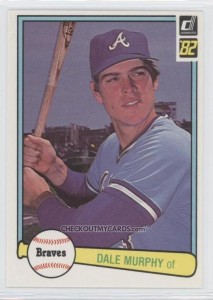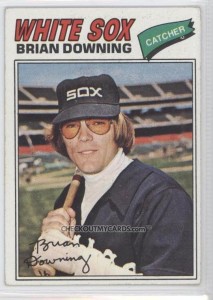High Heat Stats is an affiliate for The Hall of Nearly Great. Follow that link to purchase a copy of the book, and you’ll be supporting this blog as well.
Following are some selected quotes from the electronic book. Please consider purchasing a copy (for just $12!) to support not only a great collection of essays, but also the concept of crowd-sourcing great efforts like this. Note that the baseball card images below are from checkoutmycards.com and are not reprinted in the ebook itself.
 Joe Posnanski on Dale Murphy:
Joe Posnanski on Dale Murphy:
“That’s what I mean when I say that Murphy represented the ideal baseball player. He did not drink, did not smoke, and would always pick up the check. He would not give television interviews with his shirt off. The man endorsed milk, for crying out loud.”
Wendy Thurm on Bobby Bonds:
“There must have been a time when Barry Bonds was known as Bobby Bonds’ son. At some point, that changed.”
Jeff Passan, interviewing Marvin Miller for his essay on Andy Messersmith:
‘How are you, Marvin?’ I ask. ‘Not good,’ he says.
Marvin Miller is 95. He’s tired these days. He says he doesn’t have much time. I tell him I’d like to talk about Andy Messersmith. He talks for 30 minutes straight.”
 Sam Miller on Brian Downing:
Sam Miller on Brian Downing:
“Christopher Reeve resemblance aside, Superman isn’t the right superhero for Downing, and neither is the Incredible Hulk. Those guys were strong because of circumstances out of their control; they were merely the vehicles through which power flowed. Every major leaguer worked hard, works hard, puts in effort that we can’t imagine. But they’re, at their core, Superman. They’re the Hulk. They’ve been given their talent. Downing is, if any superhero, Batman: a self-invented force of will. He did something all of us could do, but that, in the end, none of us can do.”
Still not convinced you should buy The Hall of Nearly Great? Read my first review of the book for more excerpts and a more detailed explanation of why this project is so well worth supporting.
